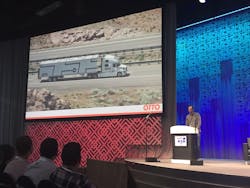LAS VEGAS. Autonomous vehicles are coming, but a diverse panel of equipment experts, technology leaders and regulators on Tuesday couldn’t agree on exactly how soon—and how extensively—self-driving trucks will move freight on American highways.
Tomorrow wouldn’t be too soon for Anthony Levandowski, who led the development of Google’s driverless car project before starting his own company, OTTO (recently bought by Uber), to bring self-driving technology to highway trucks. His add-on kits would provide auto-pilot capability to owner-operators, for starters, allowing a one-truck carrier to extend operating hours and equipment utilization. Ultimately technology will substantially streamline freight movement, both in the marketplace and on the highway, as he outlined to attendees at the American Trucking Assns. Management Conference and Exhibition here.
“The way trucks are being driven today dictates how the logistics of the whole country looks,” Levandowski explained, and he showed a graphic illustrating how distribution centers are located based on the range trucks can cover in a day. But that distance isn’t determined by the equipment, it’s determined the federal government’s hours of service limits on truck drivers, rules that “are confusing, they’re evolving, they’re hard—and they don’t quite make sense. And they’re being enforced on paper: It’s 2016, guys. How are they still enforcing HOS on paper?”
More to the point, when it comes autonomous vehicles, an hours limit on computers “doesn’t really make sense.”
Suggesting that technology is “shaped over time and it makes our lives better,” Levandowski likened the evolving movement of freight to the way elevators have improved—from the early days when operators were required to handle the controls, to today’s automated systems.
“But if you think about it, the way we drive a truck is you just have to stay in the lane,” he said. “But, up until now, we just didn’t have the right technology for seeing the world in 3-D, and understanding where the truck is driving [and its surroundings].”
And, of course, Levandowski contends that load-matching technology such as Uber’s will revolutionize the supply chain, comparing today’s brokers to telephone operators who manually patched through calls to receivers.
“It’s 2016. We now make phone calls that are automatically connected. Why aren’t shipments automatically connected from the shipper to the carrier and vice versa?” he asked.
For instance, empty miles are simply a function of the current inefficiency in the marketplace—a problem that could be greatly reduced with the right technology to pair freight with truck capacity.
But even as OTTO trucks are already being tested on the highway, and self-driving cars are increasingly spotted on city streets, the technology still faces challenges as to cost and safety before it can be widely adopted and accepted by the public (and policy makers).
For Levandowski, projected safety benefits will be demonstrated readily—largely because human drivers are so prone to error, he suggested, and he presented data charting the correlation of driver fatigue with unsafe performance.
Still, real-world testing will be required to make the case—and it’s under way.
“The goal is once you prove that technology can drive better than the best drivers, you want to take that and put it on everything,” Levandowski said.
As to costs, while there’s certainly a premium for early adopters, the savings could be substantial down the road. Levandowski envisions a future where highway tractors will be built without cabs, noting that 30-40% pf the cost of a truck is related to driver comfort. In turn, these smaller, lighter vehicles would allow for greater payloads and 24/7/365 operating capability—again, improving supply chain efficiency.
Additionally, he hinted that Uber might even offer the OTTO technology at substantially reduced prices to carriers willing to sign on to the coming Uber Freight load-matching platform.
Still, the world is not yet so efficiently and seamless as Silicon Valley visionaries might wish, and there are a number of intermediate steps still be taken before “no touch freight” becomes a hi-tech reality.
That issues will be discussed in Part 2 of this report on the MC&E panel presentation.
About the Author
Kevin Jones 1
Editor
Kevin has served as editor-in-chief of Trailer/Body Builders magazine since 2017—just the third editor in the magazine’s 60 years. He is also editorial director for Endeavor Business Media’s Commercial Vehicle group, which includes FleetOwner, Bulk Transporter, Refrigerated Transporter, American Trucker, and Fleet Maintenance magazines and websites.
